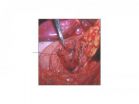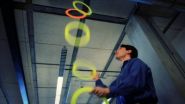(Press-News.org) While smoking among California adults has dramatically declined in recent decades, researchers at the University of California, San Diego School of Medicine report there is a surprisingly large number of people who say they use cigarettes, but don't consider themselves to be "smokers."
Writing in the February 5 online issue of Tobacco Control, Wael K. Al-Delaimy, MD, PhD, professor and chief of the Division of Global Health in the UC San Diego Department of Family and Preventive Medicine, and colleagues estimate that, in 2011, almost 396,000 Californians (12.3 percent of the state's population of smokers) smoked on a measurable basis, but rejected the characterization of "smoker."
Almost 22 percent of these smokers consumed tobacco on a daily basis.
Al-Delaimy said the phenomenon has both individual and social ramifications. For individuals, the behavior puts them at many of the same health risks as identified smokers. "There is no safe level of smoking," he said.
More broadly, non-identification of "non-identifying smokers" or NIS may be negatively impacting efforts to reduce tobacco consumption by overlooking a significant segment of the affected population, the researchers said. This is especially true at the clinical setting where physicians might ask patients if they smoke and patient fail to identify themselves as smokers.
In their cross-sectional analysis of the 2011 California Longitudinal Smokers Survey, Al-Delaimy and colleagues defined NIS as persons who had smoked at least 100 cigarettes in their lifetime, reported smoking at least one day in the past 30 days or who said they smoked at least "some days." In all cases, when asked if they considered themselves to be a smoker, the respondents replied "No."
The researchers believe NIS can generally be divided into two groups with distinct rationalizations for asserting their non-smoker status: According to previous studies, the first group consists of young adults who primarily smoke (and drink) socially and who believe they are not addicted to nicotine. And, for the first time, NIS includes a second group of adults over the age of 45 who were formerly regular smokers and had most likely failed repeated attempts to completely quit. These people, said Al-Delaimy, might seek to avoid the label of "smoker."
"The younger NIS are typically college students who smoke as a means of social facilitation and who believe they can quit at any time," he said. "Older NIS are likely the result of stigmatization produced by comprehensive tobacco control programs. They've become marginalized parts of society who see little advantage in identifying themselves as smokers or providing accurate reports of their smoking behavior."
Often, the study authors noted, NIS belong to specific ethnic minority groups, notably black and Asian.
Al-Delaimy said the findings that NIS exist in numbers much greater than previous estimates suggests future surveys should be re-designed to better account for how smokers perceive themselves so that subsequent interventions, media campaigns and public health policies can be refined to more effectively reach smokers who don't think they're smokers.
"There is a risk for such smokers to continue to smoke and be adversely impacted by the tobacco they smoke, yet they do not seek any assistance nor do they plan to quit because they falsely believe they are not smokers," Al-Delaimy said. "This more complex issue of identity and self-perception of smokers in today's social environment will require further studies and understanding."
INFORMATION:
Co-authors of this study are Eric C. Leas, Rong W. Zablocki and Steven D. Edland of the UCSD Department of Family and Preventive Medicine.
Funding support came, in part, from the State of California Department of Health Services and the University of California, San Diego.
I smoke, but I'm not a smoker
Why some 'non-identifying smokers' face risks while denying the behavior
2014-02-11
ELSE PRESS RELEASES FROM THIS DATE:
Dartmouth study provides first global evidence that foreign aid boosts public opinion
2014-02-11
A study by Dartmouth and Australian researchers provides the first empirical evidence using data from a variety of countries that foreign aid can greatly improve foreign public opinion of donor countries.
The findings are based on a U.S. foreign aid program targeting HIV and AIDS -- the President's Emergency Plan for AIDS Relief (PEPFAR) -- that has substantially improved public perception of the United States in the more than 80 developing countries receiving the aid. But the findings have broader policy implications for an emerging international order in which major ...
Game changer: Biomarker identified for noncancerous pancreatic cysts
2014-02-11
INDIANAPOLIS -- Researchers at the Indiana University School of Medicine have discovered a highly accurate, noninvasive test to identify benign pancreatic cysts, which could spare patients years of nerve-racking trips to the doctor or potentially dangerous surgery.
The findings are reported in "Vascular Endothelial Growth Factor, a Novel and Highly Accurate Pancreatic Fluid Biomarker for Serous Pancreatic Cysts" online in the Journal of the American College of Surgeons.
The test, which analyzes fluid from pancreatic cysts, can identify a common type of benign cyst that ...
New target isolated for leukemia drug development
2014-02-11
SAN ANTONIO (February 11, 2014) – There are potentially effective treatments for acute myeloid leukemia (AML), but they only work in 20 to 40 percent of cases. In a paper published today in Leukemia, a Nature journal, a UT Health Science Center researcher has pinpointed a protein that could play a key, previously unknown role in the development of pediatric AML — promising new information in the quest to treat and cure childhood leukemias.
AML starts at the point when cells mature into different kinds of blood cells. In AML, the cancerous cells grow and proliferate in ...
No clowning around: Juggling sheds light on how we run
2014-02-11
Juggling may seem like mere entertainment, but a study led by Johns Hopkins engineers used this circus skill to gather critical clues about how vision and the sense of touch help control the way humans and animals move their limbs in a repetitive way, such as in running. The findings eventually may aid in the treatment of people with neurological diseases and could lead to prosthetic limbs and robots that move more efficiently.
The study was published online recently by the Journal of Neurophysiology and will be the cover article in the journal's March 2014 print edition.
In ...
EU rules are denying children latest cancer drugs
2014-02-11
Children with cancer are being denied new, potentially life-saving drugs, because EU rules are allowing companies to trial some drugs only in adults, leading cancer experts warn today.
Changes to how EU rules are implemented could allow children access to a goldmine of potential cancer drugs which have currently only been tested in adults – by making it more difficult for pharma companies to avoid testing them in under-18s too.
Under the current system, pharma companies often gain exemptions from carrying out expensive testing of cancer drugs in patients under the age ...
Heart attack research discovers new treatment target
2014-02-11
New Orleans, LA – Research led by David Lefer, PhD, Professor and Director of the Cardiovascular Center of Excellence at LSU Health Sciences Center New Orleans School of Medicine, demonstrates for the first time cross-talk between two protective signaling molecules during a heart attack. By providing new and important information about the mechanisms involved in heart attacks and organ transplantation, the research identifies a potential new treatment target for heart disease. The paper will be published in Proceedings of the National Academy of Sciences (PNAS) Online Early ...
Point-of-care ultrasound for suspected appendicitis in kids proves accurate
2014-02-11
New York, NY – Using portable ultrasound as a first-line imaging study in kids with suspected appendicitis helps reduce emergency room length of stay and reduces the need for CT scans, according to a team of Mount Sinai researchers. Bedside ultrasound, often referred to as point-of-care ultrasonography, has a specificity of about 94%, meaning that it misses few cases, , the Mt. Sinai researchers add. Results from the study are published online February 10 in the peer-reviewed journal Academic Emergency Medicine.
"From an institutional perspective, this is the most common ...
ASTRO and SSO issue consensus guideline on margins for breast-conserving surgery with WBI
2014-02-11
Fairfax, Va., February 10, 2014 – The American Society for Radiation Oncology (ASTRO) and the Society of Surgical Oncology (SSO) are pleased to announce the publication of the consensus guideline on margins for breast-conserving surgery with whole-breast irradiation in stages I and II invasive breast cancer. The guideline document represents an intensive collaboration among experts in the radiation oncology and surgical oncology fields, led by Meena S. Moran, MD, associate professor of the Department of Therapeutic Radiology at Yale School of Medicine in New Haven, Conn., ...
Maps show expected redistribution of global species due to climate change
2014-02-11
As climate change unfolds over the next century, plants and animals will need to adapt or shift locations to follow their ideal climate. A new study provides an innovative global map of where species are likely to succeed or fail in keeping up with a changing climate. The findings appear in the science journal Nature.
As part of a UC Santa Barbara National Center for Ecological Analysis and Synthesis (NCEAS) working group, 18 international researchers analyzed 50 years of sea surface and land temperature data (1960-2009). They also projected temperature changes under ...
Obese children more likely to have complex elbow fractures and further complications
2014-02-11
ROSEMONT, Ill.─Pediatric obesity is currently an epidemic, with the prevalence having quadruped over the last 25 years. Children diagnosed with obesity can be at risk for various long-term health issues and may be putting their musculoskeletal system at risk. According to new research in the February issue of the Journal of Bone and Joint Surgery (JBJS), obese children who sustain a supracondylar humeral (above the elbow) fracture can be expected to have more complex fractures and experience more postoperative complications than children of a normal weight.
"These ...
LAST 30 PRESS RELEASES:
Making lighter work of calculating fluid and heat flow
Normalizing blood sugar can halve heart attack risk
Lowering blood sugar cuts heart attack risk in people with prediabetes
Study links genetic variants to risk of blinding eye disease in premature infants
Non-opioid ‘pain sponge’ therapy halts cartilage degeneration and relieves chronic pain
AI can pick up cultural values by mimicking how kids learn
China’s ecological redlines offer fast track to 30 x 30 global conservation goal
Invisible indoor threats: emerging household contaminants and their growing risks to human health
Adding antibody treatment to chemo boosts outcomes for children with rare cancer
Germline pathogenic variants among women without a history of breast cancer
Tanning beds triple melanoma risk, potentially causing broad DNA damage
Unique bond identified as key to viral infection speed
Indoor tanning makes youthful skin much older on a genetic level
Mouse model sheds new light on the causes and potential solutions to human GI problems linked to muscular dystrophy
The Journal of Nuclear Medicine ahead-of-print tip sheet: December 12, 2025
Smarter tools for peering into the microscopic world
Applications open for funding to conduct research in the Kinsey Institute archives
Global measure underestimates the severity of food insecurity
Child survivors of critical illness are missing out on timely follow up care
Risk-based vs annual breast cancer screening / the WISDOM randomized clinical trial
University of Toronto launches Electric Vehicle Innovation Ontario to accelerate advanced EV technologies and build Canada’s innovation advantage
Early relapse predicts poor outcomes in aggressive blood cancer
American College of Lifestyle Medicine applauds two CMS models aligned with lifestyle medicine practice and reimbursement
Clinical trial finds cannabis use not a barrier to quitting nicotine vaping
Supplemental nutrition assistance program policies and food insecurity
Switching immune cells to “night mode” could limit damage after a heart attack, study suggests
URI-based Global RIghts Project report spotlights continued troubling trends in worldwide inhumane treatment
Neutrophils are less aggressive at night, explaining why nighttime heart attacks cause less damage than daytime events
Menopausal hormone therapy may not pose breast cancer risk for women with BRCA mutations
Mobile health tool may improve quality of life for adolescent and young adult breast cancer survivors
[Press-News.org] I smoke, but I'm not a smokerWhy some 'non-identifying smokers' face risks while denying the behavior



